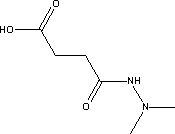Product show
Daminozide
Identification
Synonyms: N-dimethylaminosuccinamic acid (IUPAC); N-dimethylamino-beta-carbamyl propionic acid; succinic acid mono(2,2-dimethylhydrazide); butanedioic acid mono(2,2-dimethylhydrazide); DMASA; aminozide; SADH; B 995; Dimas; alar-85; Kylar; 'Alar' (Chemtura); 'B-Nine' (Chemtura). Other products 'Dazide' (Fine).
CAS No.: 1596-84-5
EC No.: 216-485-9
RTECS No.: WM9625000
Molecular Weight: 160.17
Molecular Formula: C6H12N2O3
Structural Formula: 
Form: Tech. is a white powder, with a faint amine-like odour.
M.p.: 156–158 °C
V.p.: 1.5 mPa (25 °C)
Kow: logP = –1.49 (pH 5) , –1.51 (pH 7), –1.48 (pH 9) (21 °C)
S.g./density: 1.33 (21 °C)
Solubility: In distilled water 180 g/l (pH not determined, 25 °C). In methanol 50, acetone 1.9 (both in g/l, 25 °C). Insoluble in hydrocarbons.
Stability: No measurable hydrolysis over 30 d at pH 5, 7 and 9. Hydrolysed by acids and alkalis on heating. Solutions are slowly decomposed by light. pKa 4.68 (20 °C)
Application
Daminozide interferes with gibberellic acid biosynthesis. Mode of action Absorbed by the leaves, with translocation throughout the plant. Used To produce more compact plants (by inhibition of internodal elongation) of chrysanthemums, azaleas, hydrangeas, poinsettias, and other ornamentals. Applied at 0.106–0.425 kg/ha. Daminozide is banned to use on food crops.
Specification*
Daminozide purity: 99.5% min.
m.p.: 154-156°C
Insolubles in water: 0.02% max.
Loss after drying: 0.2% max.
Appearance: white crystalline powder
Standard Packaging
25kg/Fiber drums
Risks and Safety Information
Daminozide is not regulated by UN as hazardous substance
Oral Acute oral LD50 for rats >5000 m/kg. Skin and eye Acute percutaneous LD50 for rabbits >5000 mg/kg. Birds Dietary LC50 (8 d) for mallard ducks. Fish LC50 (96 h) for rainbow trout 149. Algae EC50 for Chlorella 180 mg/l. Bees Not toxic to bees; LD50 >100 μg/bee (85% formulation). Worms LC50 for earthworms >632 ppm.
